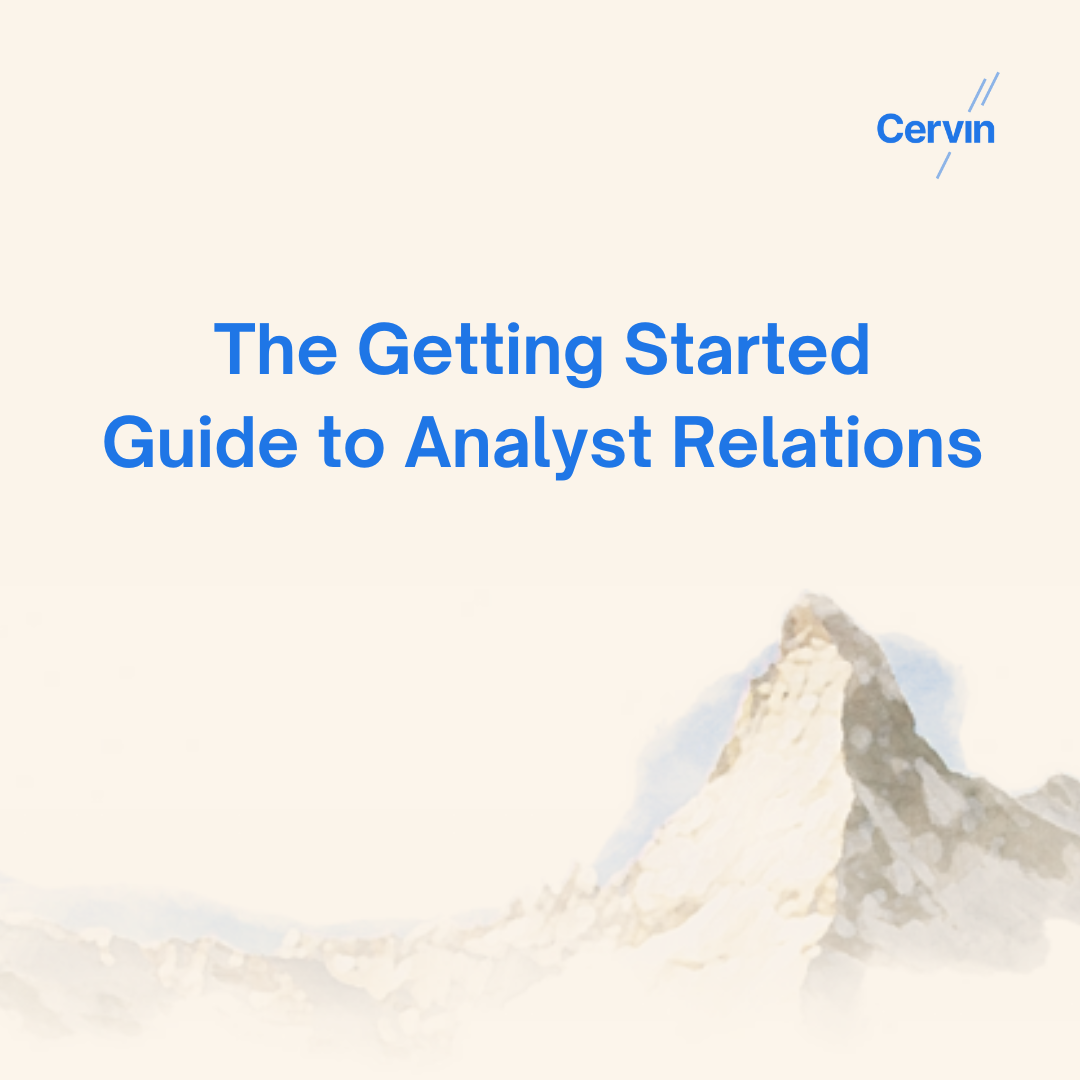The tenor of my conversations with marketing leaders in Cervin’s portfolio has shifted as we move into the second half of 2024. The marketing vibe has shifted from “maintaining revenue” to more of a growth orientation. While the days of “grow at all costs” are not returning, marketing leaders are spending time to figure out how to efficiently drive revenue, qualified leads, and brand visibility as spending in B2B technology seems to be accelerating.
While I do not believe there are any silver bullets for marketing-driven revenue (I’m looking at you, expensive ABM intent data platforms), I think there are marketing program, such as Analyst Relations, that the current generation of startups haven’t been leveraging in their B2B GTM motion.
While writing about insights CEOs need to know about AR, I pinged Charlie Guyer, principal and founder of the Guyer Group, for the latest insights on how their clients are engagingindustry analysts like Forrester, Gartner, IDC, et al.
(I worked with Charlie at Cisco where he ran the Analyst Relations function. I learned everything I know about AR from Charlie and his team, and he’s had a front-row seat to the evolution of analysts as an influencer channel having worked with tech companies and analysts for almost 30 years now.)
I thought I knew AR, but given how much I (re)learned about current best practices from my conversations with Charlie and team, we decided to summarize the answers to some of the most common questions I receive from startups about analysts.
1) When should a technology startup first engage the analyst firms?
Short answer: “it depends.” Engaging analysts should be evaluated early in the startup's lifecycle, but deciding to invest in AR over other GTM activities depends on questions such as:
-
Is there an existing category or research area that analysts are active in? It is often easier to provide a new perspective on an existing area or market than to convince an analyst that your startup is doing is focused on something completely new and unique. There is a time and place for category-creation efforts, but at an early stage it’s not efficient to focus on category-creation efforts until you have more momentum.
-
Are the analysts covering your space influencing the purchasing decisions of your ICP’s buying committee? This is very common when selling directly to CIOs or CISOs. If you know customers are talking to analysts in their diligence, you need to think about how they could accelerate or slow your selling motion. Once you know your customers are consulting with analysts, the devil is in the details of: WHO do you engage, HOW to best engage them, and WHAT can you realistically expect from your efforts.
-
Can your company (not just marketing) dedicate resources to this channel? Similar to other activations, focusing on AR not only requires a marketing/comms lead, but also cross-functional support within the company (e.g. senior leadership, product, customer success, etc). If you want to invest in AR, but your cross-functional SMEs and leadership can’t commit to it, you won’t have a successful program. Wait until you can convince all of your internal stakeholders of the potential value.
There are some company milestones that can also signal that now might be a good time to start with analysts. For example:
-
Product Development: As you develop your product features and roadmap, analysts can offer critical feedback and validation by aggregating the many conversations they’ve had with your ICP.
-
Product launch: As you plan your go-to-market, analysts can provide market insights, competitive intelligence, or messaging feedback based on their interactions with your buyers. In the best case, they might even provide 3rd party validation for to the media on why your product or vision is something customers should pay attention to.
-
Funding Rounds: Engaging analysts before significant funding rounds can help provide them with additional context that may be beneficial in media or customer interactions.
2) What is the value to the startup to work with the analysts?
Working with industry analysts offers many benefits beyond just being included in a written report or research note. Many startups view the written report as the only value analysts can provide, but that’s only the tip of the iceberg. For every piece of written content, analysts are likely handling 1,000s of inquiries and private conversations with your customers. Being top-of-mind with analysts can help drive:
-
Revenue Growth: Analysts can materially impact your top-line growth by putting you on recommended lists or advising customers on how to evaluate competing solutions they’re considering.
-
Market and Vision Validation: Ongoing dialogue with analysts can help you refine your technology and market positioning by providing a comprehensive market view. Since they’re sharing that POV with your customers, you want the opportunity to shape what they may be telling your buyers.
-
Competitive Intelligence: Analysts provide insights into market trends, competitors’ strategies, and emerging technologies that may impact your GTM.
-
Strategic Guidance: They offer valuable feedback on your product, business model, and market approach, helping you refine your strategy.
3) As a startup, how do you identify the right analysts to work with?
Identifying the right analysts involves a lot of research. In that sense, it is no different than researching what VCs to approach for funding, or reporters to pitch on your big news. Here are some suggestions for finding the right analyst:
-
Research analyst coverage: Look at which analysts cover your tech domain and industry. Review their past reports, blogs, media mentions and social media to gauge their expertise, influence, POV and frequency of posting.
-
Look for a similar worldview: Identify analysts who you think align with your view on the market and your GTM goals. The ideal analysts to start with are the ones that share your vision – and have influence with your target customer. Remember their POV doesn’t need to align 100% with your vision, but it will be easier to have a dialogue with someone who already is 80% aligned than someone who completely disagrees with you.
-
Don’t fixate on the analyst “brand”: When starting an AR program, don’t fixate on engaging that one, rock-star analyst from the biggest name-brand firm. If you want to talk to them, so does everyone else. Be sure to audit the individuals at multiple firms – and don’t overlook the niche, boutique firm – to find the individual you can start a dialogue with. You can expand and diversify the pool of analysts you engage later, but you need to find that first analyst to build your program around.
-
Ask for recommendations: Ask your customers, industry peers, investors, and advisors for recommendations on which analysts have been most impactful in your space. This will also help you identify the role analysts play in your purchase process.
4) What are best practices for your first engagement with industry analysts?
Your first engagement with industry analysts sets the tone for a long-term relationship. Here are best practices to ensure a successful start:
-
Preparation:
-
Understand the analyst's focus: Research the analyst’s previous work and focus areas to tailor your messaging. Analyst firms like Gartner have been very deliberate in publishing research notes on how to best work with them - follow their advice to get off on the right foot.
-
Clarify your objectives: Define clear objectives for the engagement. Are you just introducing yourself, seeking market feedback or pitching that you should be included in an upcoming report?
-
Prepare: Don’t wing it. Have a clear plan and supporting materials, including a concise pitch, product demos, and case studies. Make sure everyone on your internal team knows their role and the goals for the meeting.
-
-
Initial Meeting:
-
Be concise and clear: Clearly articulate your value proposition, market differentiation, and strategic vision. However much time you have with an analyst, expect that you only have half the time to deliver your key messages. The rest of the time will usually be taken up by discussion and feedback.
-
Listen and learn: Be open to feedback. Analysts can offer valuable insights that can shape your strategy. Listening can be a difficult skill for startups with strong conviction in their product and vision. Rather than arguing with an analyst, use the opportunity to understand the “why” behind their perspective.
-
Build rapport: Establish a personal connection and show your willingness to engage in an on-going dialogue. Don’t be transactional and play the long game.
-
-
Follow-Up:
-
Actionable insights: Act on the feedback provided and keep the analyst informed of any significant developments or improvements.
-
Regular updates: Maintain regular communications to keep analysts updated on your progress, milestones, and successes.
-
5) Do I need to pay analysts? Are all engagements pay-for-play?
The short answer is “no.” You can meet with analysts of all varieties without the exchange of dollars.
That said, when you identify analysts who look like long-term collaborators, it can be helpful to find ways outside of briefings that you can work with analysts as part of your go-to-market efforts.
This could mean subscribing to their research, it could be working together on a project -- such as a piece of market or customer research -- that will help you achieve your overall business goals. This type of paid engagement gives you a different, longer-duration mechanism for engaging analysts since there are only so many free briefings they can accept.
Paying analysts comes down to value. If you find firms or individuals that add value to your GTM, don’t be scared to invest in it like you would any other relationship. Follow the value but don’t blindly spend dollars if you’re not seeing an ROI.
… so should I start an analyst relations program?
It’s clear engaging with industry analysts can impact your startup’s GTM in a variety of ways. But like most marketing programs, you can also burn a lot of time and resources without tangible results. Before deciding to launch a formal AR program, do the foundational work of researching analysts, aligning your internal teams, and developing a plan on the role analysts will play in your GTM.
… but what if I have more questions?
Working with analysts is a nuanced program. Despite running successful AR programs in the past, I realized in my conversations with Charlie and Kevin Whalen how much the analyst landscape has changed. If you want to learn more and explore starting your own program, I’d suggest reaching out to Guyer Group to get an expert’s view. Like many marketing programs, many people say they do AR, but few firms or individuals really focus on the strategic role analysts can play in your GTM motion.
We hope these insights were helpful. If you have more questions about AR that we can try to answer, drop me a note at scott@cervinventures.com.





